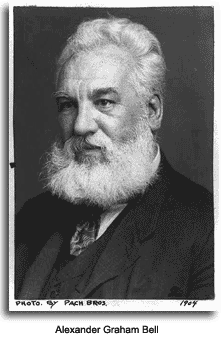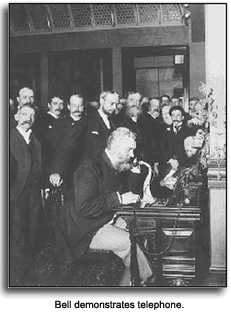"There cannot be mental atrophy in any person who continues to observe, to remember what he observes, and to seek answers for his unceasing hows and whys about things." - Alexander Graham Bell.
Alexander Graham Bell grew up in Edinburgh, Scotland, in an educational environment. His father, Alexander Melville Bell, was a teacher of Visible Speech. Alexander Graham was always interested in how things worked and continued with that inclination by inventing numerous things. On March 7, 1876, the United States Patent Office granted him Patent Number 174,465 for his invention of the telephone.
 Alexander founded the Bell Telephone Company in 1877 and continued his work as a prolific inventor. His output included photophone, metal detector, experimental aircraft, hydrofoil, and eugenics. The scientific terms for relative strength, the bel and decibel, are named for him. His inventions changed the way the world communicates, and he managed to influence drastic changes in aviation and hydrofoil technology as well. His influence on the world earned him a place on the top 10 list of "Greatest Canadians" by the Canadian Broadcasting Corporation. He would continue to test new ideas through a long and productive life.
Alexander founded the Bell Telephone Company in 1877 and continued his work as a prolific inventor. His output included photophone, metal detector, experimental aircraft, hydrofoil, and eugenics. The scientific terms for relative strength, the bel and decibel, are named for him. His inventions changed the way the world communicates, and he managed to influence drastic changes in aviation and hydrofoil technology as well. His influence on the world earned him a place on the top 10 list of "Greatest Canadians" by the Canadian Broadcasting Corporation. He would continue to test new ideas through a long and productive life.
Telephone genius
Invention of the telephone progressed out of improvements Bell made to the Telegraph. He had developed the "harmonic telegraph," which could send more than one message at a time over a single telegraph wire. Bell reasoned that it would be possible to pick up all the sounds of the human voice using an adaptation of the "harmonic telegraph." In 1875 Bell, with his assistant Thomas A. Watson, constructed instruments that transmitted recognizable, voice-like sounds.
Bell's first telephone patent was granted on March 7, 1876. Three days later he and Watson, located in different rooms, successfully completed a "clear-as-a-bell" type of transmitter. The first telephone firm, Bell Telephone Company, was founded on July 9, 1877.
Photophone
Among one of Alexander's first innovations following the telephone was the "photophone," a device that enabled sound to be transmitted on a beam of light — the principle upon which today's laser and fiber optic communication systems are based.
Bell and his assistant, Charles Sumner Tainter, developed the photophone using a sensitive selenium crystal and a mirror that vibrated to a sound. In 1881, they successfully sent a photophone message approximately 200 yards from one building to another. Bell regarded the photophone as, "the greatest invention I have ever made — greater than the telephone."
Medicine man
Bell did not stop with his groundbreaking communication inventions. His passion for exploration, never stopping at satisfaction, guided him into both medicine and aviation.
After a successful period of working to eliminate genetic irregularities in sheep, Bell extended his medical curiosity to humans.
In 1881 he constructed an electromagnetic device called an Induction Balance, to (unsuccessfully) locate a bullet that lodged in President Garfield following an assassination attempt. He later improved upon the instrument and produced a device called a telephone probe, which made a telephone receiver click when it touched metal.
During that year, Bell's newborn son, Edward, died from respiratory problems, and Bell responded to the tragedy by designing a metal vacuum jacket that simulated breathing. The amazing apparatus became a precursor of the iron lung used in the 1950s to aid polio victims.
 The sky is the limit
The sky is the limit
Alexander spent many years researching and constructing his many inventions. However, the time and energy that he put into aviation dwarfs the time spent on other projects. By the 1890s, Bell had begun to experiment with propellers and kites. His work led him to apply the concept of the tetrahedron* to kite design as well as to create a new form of architecture.
In 1907, Bell formed the Aerial Experiment Association with young engineers Glenn Curtiss, William "Casey" Baldwin, Thomas Selfridge, and J.A.D. McCurdy, whose common goal was to build airborne vehicles. By 1909, the group had produced four powered aircraft, the best of which, the Silver Dart, made the first successful powered flight in Canada on February 23, 1909.
An end to greatness
Bell continued to research aviation well into his later years. He also became fascinated with the hydrofoil** and boat racing. In 1919 he and partner Casey Baldwin built a hydrofoil boat that set a world record not broken until 1963.
Alexander Graham Bell passed away in Baddeck, Nova Scotia, on August 2, 1922.
"Leave the beaten track occasionally and dive into the woods. Every time you do so you will be certain to find something that you have never seen before. Follow it up, explore all around it, and before you know it, you will have something worth thinking about to occupy your mind. All really big discoveries are the results of thought."- Alexander Bell.